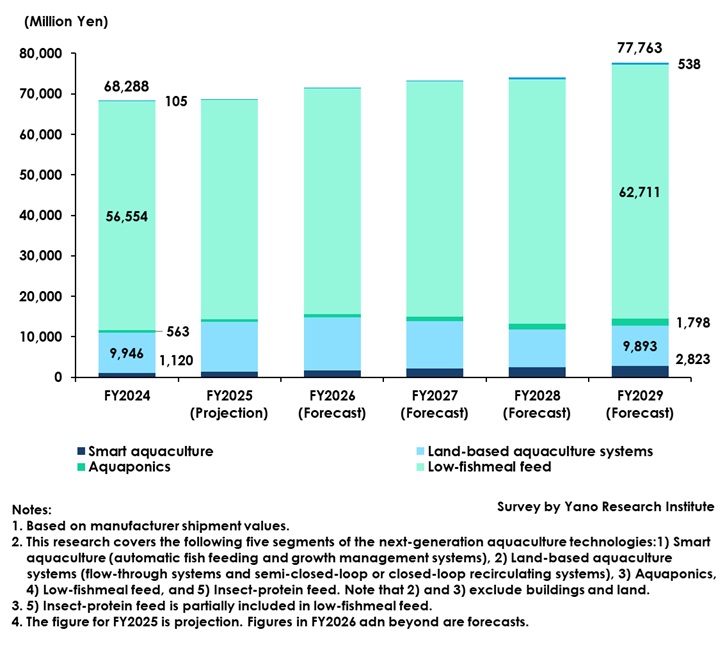No.3897
Next-Generation Aquaculture Business in Japan: Key Research Findings 2025
The Market Size for Five Next-Generation Aquaculture Technology Segments in Japan Reached 68.288 Billion Yen in FY2024
Yano Research Institute (the President, Takashi Mizukoshi) conducted a survey of the next-generation aquaculture technology market in Japan and revealed the market size, trend of market players, and future perspectives.

Market Overview
As the world's population grows, food insecurity continues to worsen. According to the Ministry of Agriculture, Forestry and Fisheries’ (MAFF) food balance sheet, global demand for fishery products is increasing, even as the seafood supply per person in Japan declines.
Against this backdrop, ensuring a stable seafood supply through domestic aquaculture has become increasingly important, both within Japan and internationally. This study examines five types of next-generation aquaculture technologies: “smart aquaculture,” which uses ICT-based systems such as automatic fish feeding and fish growth management; “land-based aquaculture systems,” which enable fish production on land; “aquaponics,” an integrated farming system that reuses waste from aquaculture to cultivate plants; “low-fishmeal feed,” which contains a reduced proportion of fishmeal; and “insect-protein feed,” which is made from insect-derived ingredients.
Based on manufacturer shipment values, the domestic market size for these five next-generation aquaculture technology segments was estimated at 68.288 billion yen in FY2024. Specifically, the values were as follows: low-fishmeal feed, 56.554 billion yen; land-based aquaculture systems (semi-closed-loop and closed-loop recirculating systems), 9.946 billion yen; smart aquaculture (automatic fish feeding systems and fish growth management systems), 1.12 billion yen; aquaponics, 563 million yen; and insect-protein feed, 150 million yen.
Noteworthy Topics
Full-Scale Implementation of Aquaponics in Japan
Aquaponics is a system that integrates aquaculture (fish production) with hydroponics (growing plants in water). Japan introduced this system in the 2010s and began full-scale implementation in the 2020s.
The system is characterized by the recirculation of water for the cultivation of both fish and plants. Fish waste and other byproducts that were previously discarded are now utilized as plant nutrients.
In aquaponic systems, plants are cultivated in hydroponic setups that circulate water to and from aquaculture tanks. These systems are commonly used to grow leafy vegetables, such as lettuce, as well as herbs.
Because the water is continuously recirculated, freshwater is generally used instead of seawater. The fish produced are typically freshwater species, such as sturgeon and tilapia. However, Japan has also been researching seawater-based aquaponics, as marine fish are more commonly produced through aquaculture.
Future Outlook
Based on manufacturer shipment values, the domestic market size of the next-generation aquaculture technologies is expected to reach 77.763 billion yen by FY2029. Specifically, the low-fishmeal feed segment is expected to reach 62.711 billion yen; land-based aquaculture systems (semi-closed-loop and closed-loop recirculating systems) are expected to generate 9.893 billion yen; smart aquaculture systems (automatic fish feeding and growth management) are expected to be valued at 2.823 billion yen; aquaponics is expected to reach 1.798 billion yen; and insect-protein feed is expected to generate 538 million yen.
The market for smart aquaculture is forecast to grow, driven by the expansion of marine aquaculture areas and greater efficiency and automation in fish feeding.
The land-based aquaculture market is projected to expand through FY2026, as large-scale facilities are constructed. However, construction activity is expected to decline after FY2027, causing the market size in FY2029 to return to a level similar to that in FY2024.
The aquaponics market appears promising, supported by an expected increase in the number of facilities, broader adoption by medium- and large-sized companies, and a wider variety of plants and aquatic species cultivated through seawater-based aquaponics. In addition, land-based aquaculture continues to attract growing attention.
The low-fishmeal feed market is expected to experience modest growth as rising fishmeal prices stabilize and overall demand continues to expand steadily.
The insect-protein feed market is anticipated to grow further, driven by increased adoption amid greater attention to improving the immunity of cultured fish. Insect-protein feed is recognized not only as a high-value feed that enhances fish immunity, but also as a product that can be mass-produced domestically.
Research Outline
2.Research Object: Businesses developing next generation aquaculture technologies (smart aquaculture, land-based aquaculture systems, aquaponics, low fishmeal feed, and insect-protein feed), fish farm companies, universities, related public organizations, and R&D institutions
3.Research Methogology: Face-to-face interviews (including online interviews) by expert researchers, survey via phone/email, and literature research
What is the Next-Generation Aquaculture Technology Market?
This research covers the following five segments of the next-generation aquaculture technology market: 1) Smart aquaculture (automatic fish feeding and growth management systems), 2) Land-based aquaculture systems (flow-through systems and semi-closed-loop or closed-loop recirculating systems), 3) Aquaponics, 4) Low-fishmeal feed, and 5) Insect-protein feed. Market size is based on manufacturer shipment values.
The following items were included for each technology segment:
1) For smart aquaculture, the total value of automatic fish feeding and growth management systems is included.
2) Land-based aquaculture systems generally encompass three types: flow-through, closed-loop, and semi-closed-loop recirculating systems. Flow-through systems pump water from the ocean through the system and do not recirculate the water. Closed-loop recirculating systems purify and recirculate water for reuse within the system. Semi-closed-loop recirculating systems partially recirculate the water and partly drain it. This research focuses on closed-loop and semi-closed-loop systems. Please note that the market size excludes buildings and land.
3) Aquaponics is a sustainable farming method that combines aquaculture and hydroponics, where plants grow using waste output from fish grown in aquaculture.
4) Low-fishmeal feed contains 50% or less fishmeal and is sold by each manufacturer.
5) Insect-protein feed is made from insects.
<Products and Services in the Market>
Smart aquaculture (automatic fish feeding and growth management systems), land-based aquaculture systems (closed-loop and semi-closed-loop recirculating systems), aquaponics, low-fishmeal feed, and insect-protein feed.
Published Report
Contact Us
The copyright and all other rights pertaining to this report belong to Yano Research Institute.
Please contact our PR team when quoting the report contents for the purpose other than media coverage.
Depending on the purpose of using our report, we may ask you to present your sentences for confirmation beforehand.